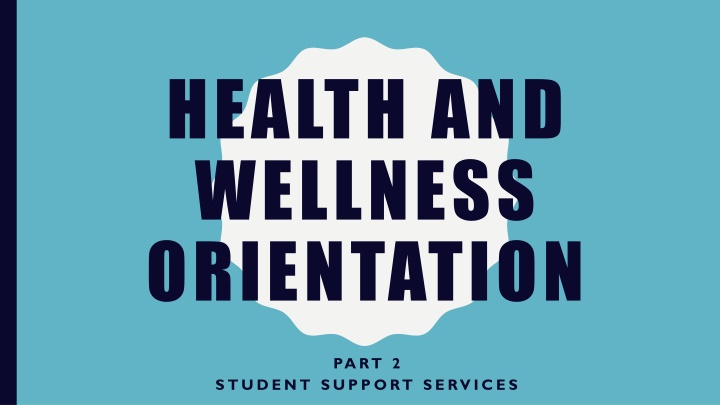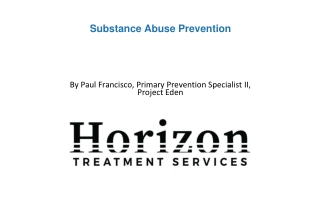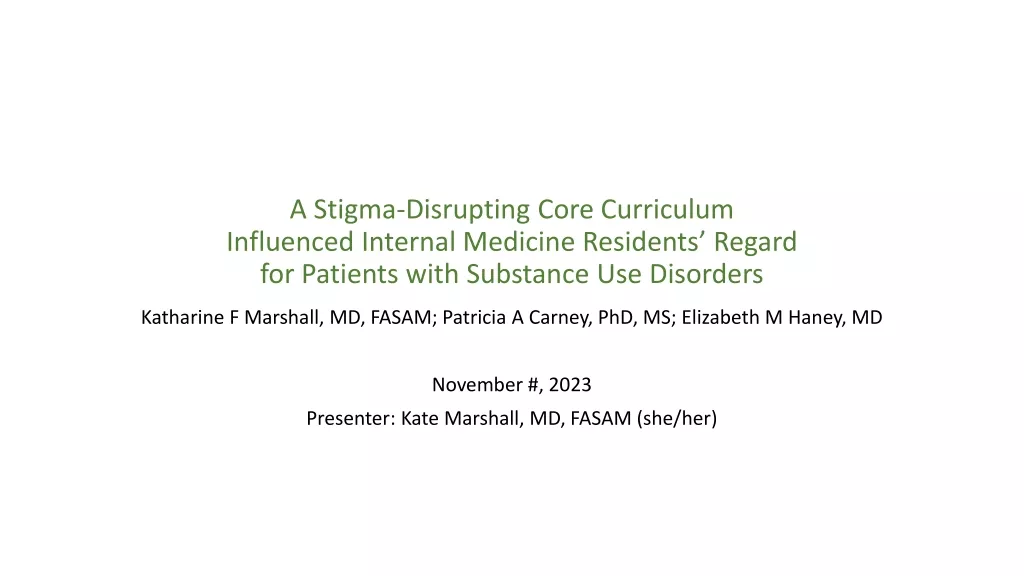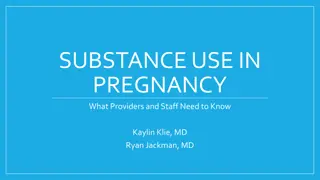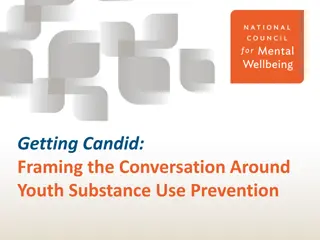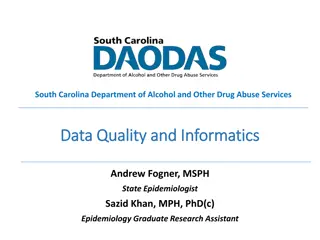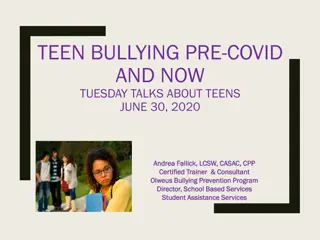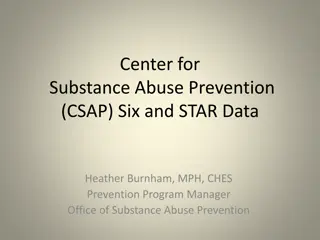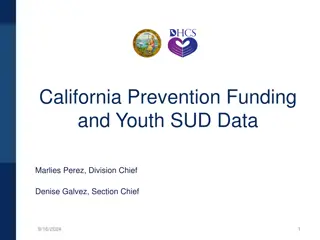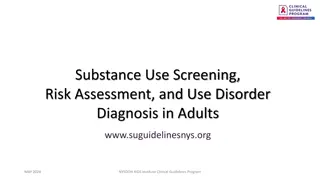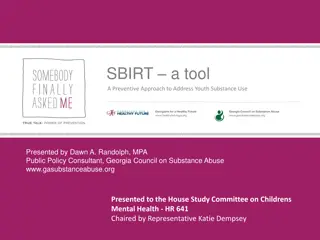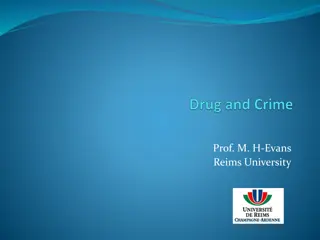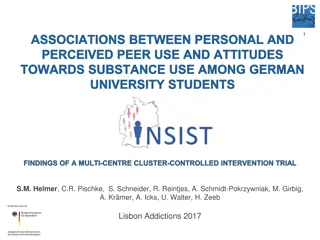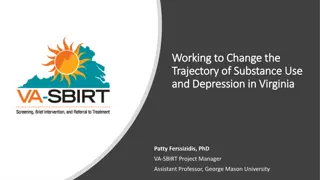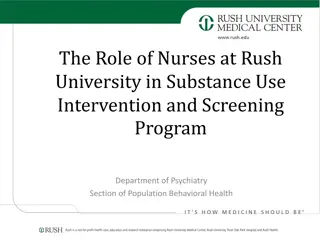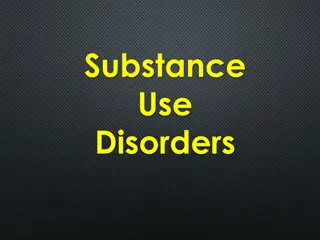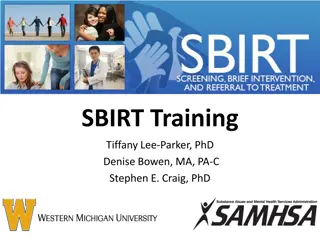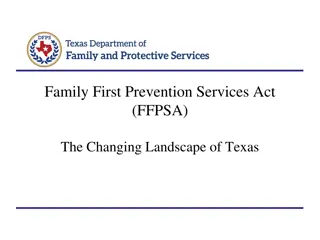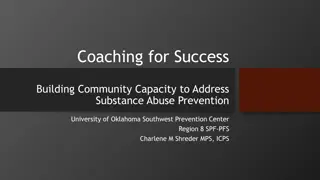Substance Use Prevention and Education Services
This presentation covers substance use prevention, education, and intervention services, as well as drug and alcohol testing requirements for Job Corps students. It emphasizes identifying substance use problems, relapse prevention, and helping students overcome employability barriers.
Download Presentation

Please find below an Image/Link to download the presentation.
The content on the website is provided AS IS for your information and personal use only. It may not be sold, licensed, or shared on other websites without obtaining consent from the author.If you encounter any issues during the download, it is possible that the publisher has removed the file from their server.
You are allowed to download the files provided on this website for personal or commercial use, subject to the condition that they are used lawfully. All files are the property of their respective owners.
The content on the website is provided AS IS for your information and personal use only. It may not be sold, licensed, or shared on other websites without obtaining consent from the author.
E N D
Presentation Transcript
HEALTH AND WELLNESS ORIENTATION PART 2 STUDENT SUPPORT SERVICES
THE POLICY AND REQUIREMENTS HANDBOOK PRH Chapter 2, sections 2.3 R5-R10 Refer to PRH for policy Policy in this presentation has been paraphrased
TEAP PRH 2.3 R5
TEAP SERVICES The general emphasis of TEAP must be on: Prevention Education Identification of substance use problems Relapse prevention Helping students overcome barriers to employability
SUBSTANCE USE PREVENTION AND EDUCATION, TO INCLUDE: 1. Minimum of a one-hour presentation on substance use prevention for all new students during the Career Preparation Period. This presentation must explain (1) TEAP prevention, education, and intervention services,(2)Job Corps drug and alcohol testing requirements and procedures,and (3) the consequences of testing positive for drug or alcohol use while in Job Corps 2. Presentation(s) on managing substance misuse, abuse, and dependency symptoms and issues in the workplace for students during the Career Development and Transition Periods 3. At least three annual center-wide substance use prevention and education activities
DRUG AND ALCOHOL TESTING [PRH 2.3, R5(E)] Drug testing procedures who gets tested: New and readmitted students Students who tested positive on entrance shall be retested between the 37th and 40th day after arrival on center. Students who are suspected of using drugs at any point after arrival on center (if positive = ZT termination) Biochemical testing is never permissible on a random basis If a student refuses to provide a specimen or has an unexcused absence from his or her follow-up (both 45-day and suspicion) drug test this is a ZT Termination Students who state they are unable to produce a specimen shall be referred to the center physician or designee for follow up
IDENTIFICATION OF STUDENTS AT RISK c. Assessment for identification of students at risk for substance use problems to include: 1. Review of Social Intake Form (SIF) or intake assessment of all students performed by counseling staff within one week of arrival 2. Formalized assessment measures (e.g., SASSI3 or SASSIA2), and clinical judgment to determine students level of risk for substance use 3. Collaboration with the Center Mental Health Consultant to determine when a MSWR or medical separation is appropriate and should be recommended for a student with substance use conditions (see [PRH 2.3, R5(e5)])
OTHER DUTIES 4. Clinical consultation with Center Director, management staff, Center Mental Health Consultant, and Health and Wellness Manager regarding substance use prevention and education efforts for students and staff 5. Coordination with other departments/programs on center, to include, but not be limited to, residential, recreation, student government association, and Healthy Eating and Active Lifestyles (HEALs), to develop integrated prevention and education services.
EDUCATION d. Intervention services for students identified at an elevated risk for substance use, to include: 1. Individual and group intervention services with a focus on behaviors that represent employability barriers 2. Collaboration with the Center Mental Health Consultant for students with co-occurring conditions of mental health issues and substance use 3. Referral to off-center substance abuse professionals or agencies for ongoing treatment and/or specialized services. Any student separating from Job Corps who has a substance use condition must be provided with a referral for support services in his or her home community
TEAP SCENARIO 1 Cheryl is a 20-year-old-student who tested positive for THC, Opiates and Benzodiazepines. Your TEAP Specialist has been concerned about Cheryl from day one. Cheryl has been on center for 35 days and she comes to you and the TEAP Specialist to inform you she thinks she needs more support and is afraid she may fail her 2nddrug screen. How should this situation be handled? A. Have the TEAP Specialist conduct an assessment to determine if she needs inpatient or intensive outpatient treatment B. Have the TEAP Specialist and the CMHC meet to discuss C. Both A & B are correct
TEAP SCENARIO 2 Jeremy is a 16-year-old student who tested positive on entry. Jeremy is called down for his Intervention Urine Drug Screen and informs the nurses he is not going to give a urine sample and no one can make him. What should you do next? A. Call his mother and inform her he refuses to give a urine sample B. Explain to Jeremy if he refuses to provide a urine sample he will be separated from the program for refusing. How did you arrive at your answer?
TEAP SCENARIO 3 Mark is a new student who was positive on entry, and he developed some medical issues and was placed on MSWR on day 15. Does the count stop while on Mark is on MSWR? Mark is out on MSWR for 30 days. What will the count be when he returns? A. depends on how long Mark is on MSWR B. day 16 C. day 15 D. day 1 the count starts over when he returns to center. E. does not matter you need to test Mark when he returns to center.
TOBACCO USE PREVENTION PROGRAM (TUPP) PRH2.3 R6
TOBACCO USE PREVENTION PROGRAM (TUPP) Be aware of federal and state laws regarding use of tobacco products by minors (center must adhere) Some states the legal age has increased to 21. Promote smoke-free environment or no smoking during the training day If center operators choose to allow tobacco use, designated smoking areas must be located at least 25 feet away from all building entrances (or whatever your state law says) What is policy on vaping and e-cigarettes (now called Electronic Nicotine Delivery Systems ENDS)? 15
FAMILY PLANNING PRH 2.3 R7
FAMILY PLANNING PROGRAM A family planning program shall be provided to all students on a voluntary basis. At a minimum, this program shall include counseling, health promotion activities, and medical services, including birth control. The Center Director shall appoint a staff member to implement and monitor this program. Students who are pregnant and/or experiencing pregnancy-related medical conditions shall be afforded the same access to medical services, leave and medical separation as any other student experiencing a medical condition, unless otherwise provided by law. 17
FAMILY PLANNING PROGRAM Once a center learns that a student is pregnant, pregnancy-related services shall include: 1. Prenatal services on center and/or in the community until separation, to include a comprehensive gestational record. 2. The center physician, in conjunction with an obstetrical/gynecological provider and the student, will agree upon a care-management and separation plan that takes into account the health and safety of the pregnant student before and after childbirth.
FAMILY PLANNING PROGRAM The center shall identify available community health/social resources and services and will make arrangements for transportation for the purpose of obtaining such resources and services consistent with PRH 6.7 R9 (d). In lieu of the center providing transportation, the center may approve a student s request to be transported by a friend, partner or family member. The center shall not pay for an abortion unless the pregnancy is the result of rape or incest or unless a physician has certified that the student suffers from a physical disorder, injury, illness, or condition that places her in danger of death unless an abortion is performed.
FAMILY PLANNING PROGRAM A student that is experiencing a pregnancy-related medical condition may be placed on paid administrative leave in accordance with PRH Exhibit 6-1. See Pay status: Paid, Duty status: Not Present for Duty-Administrative Leave with Pay. Pregnancy-related services shall include information on the options of continuing or terminating the pregnancy. If required by applicable state laws in which the center is located, the Center shall notify the student s parent/guardian of her pregnancy if she is a minor, and if required by applicable state law, inform the student of this requirement prior to the disclosure.
FAMILY PLANNING SCENARIO 1 When reviewing an applicant file on 17-year-old Susan, you determine she is 5 months pregnant and has had no problems with her pregnancy. Do you recommend denial because she is 5 months pregnant and won t have time to complete the program?
FAMILY PLANNING SCENARIO 2 Marsha is a 16 year old who has been on center for 5 months. She requests a pregnancy test and it is positive. What do you do? a. Automatically notify Marsha s guardian of the pregnancy b. Check your state s informing laws c. Encourage Marsha to call her guardian d. a. only e. b. and c.
HIV/AIDS PRH 2.3 R8
HIV/AIDS HIV/AIDS program includes: Education Testing Provide pre- and post-test counseling according to your state and local laws Follow up Case management for HIV-positive students Have student sign that they received their results (Promising practice) Submit specimens for HIV testing to the nationally contracted laboratory. Centers shall not be reimbursed for HIV tests performed at other than the nationally contracted lab. 24
EDUCATION Go over the HIV Information sheet (Form 2-02) and have the student sign. Conduct Pre-HIV Testing Counseling Contact your local Health Department to determine what should be covered in Pre- and Post- Test Counseling When giving students their results make sure to cover Post-Test Counseling Talk about safe sex
HIV TESTING Test students for HIV infection under the following circumstances: As part of the cursory medical examination (see Section 2.3, R2.c). If a student exhibits signs and/or symptoms of a possible AIDS-related condition. Upon reasonable suspicion of student exposure to HIV. When student is diagnosed with a newly contracted sexually transmitted disease. Upon student request and after physician consultation. Submit specimens for HIV testing to the nationally contracted laboratory. Centers shall not be reimbursed for HIV tests performed at other than the nationally contracted lab.
CASE MANAGEMENT The CMHC needs to be present when students testing positive for HIV are given the results. Coordinate care and case management of students seeking off center care either at home or in community.
HIV SCENARIO Johnny arrives on center and is HIV positive. You educate him on safe sex and safety precautions. Do you have Johnny sign a behavior contract regarding having sex with other students? Yes or No
HIV QUESTION Who do you notify on center that Johnny is HIV positive? a. Dorm Life Manager b. Center Career Counselor c. Only share information with the student s written permission d. Trade Instructor e. Parent or guardian
HEALTHY EATING AND ACTING LIFESTYLES (HEALS) PRH 2.3 R9
HEALS At a minimum the HEALs Programs should consist of: 1. Planning 2. Environment 3. Education and Counseling 4. Assessment Center Director establishes a Healthy Eating and Active Lifestyles Committee to oversee and coordinate this program. 31
HEALS Planning: The HEALs committee shall include at a minimum the Health and Wellness Manager, Food Services Manager/Supervisor, Recreation Supervisor or Specialist, TEAP Specialist, Residential Manager, and student representative. Planning should incorporate students interests in planning activities and there should be collaboration between various departments on center. Need to plan activities that will foster student involvement, participation, and accountability. See the HEALs website https://supportservices.jobcorps.gov/HEAL/Pages/default.aspx
HEALS Environment: should consist of a variety of fitness activities, nutritious and healthy food choices and limit non-nutritious selections on center Education and Counseling: provide a variety of educational materials that promote fitness, good nutrition and healthy choices, provide individual weight management program and counseling, and incorporate motivational interviewing and goal setting to assist student s in being successful with healthy choices Assessment: Document, monitor and asses the program. Make changes as necessary; do the Making the Grade to assess the program every 6 months
HEALS QUESTION 1 Are all centers required to have a HEALs committee?
HEALS QUESTION 2 Does the HWM have to be the HEALs Coordinator?
HEALTH ASPECTS OF SPORTS PRH 2.3 R10
HEALTH ASPECTS OF SPORTS All students must be medically cleared to participate in organized sports activities by the center physician or designee Staff certified in CPR and First Aid are present at all sports events including practice sessions Adequate transportation must be available in the event of an emergency at all sponsored events 37
IMPORTANT RESOURCES PRH 2, 2.3 R5-R10 Desk Reference Guide (DRG) HWM (update pending) Desk Reference Guide (DRG) TEAP TAGs Family Planning TAG Revised Date: July 2020 Versions:PDF format or online 38
RESOURCES (WEBSITES) Health and Wellness website https://supportservices.jobcorps.gov/Health/Pages/default.aspx Healthy Eating and Active Lifestyles website https://supportservices.jobcorps.gov/HEAL/Pages/default.aspx Health Education Curriculum https://supportservices.jobcorps.gov/health/Pages/HECurriculum.aspx Reporting Laws https://rainn.org/public-policy-action
ADDITIONAL RESOURCES Appendices Appendix 201 Communicating With Persons With Disabilities Appendix 202: Transmission, Storage, and Confidentiality of Medical, Health, and Disability-Related Information Appendix 203 Medication Management Guidelines Appendix 601 Student Rights to Privacy and Disclosure of Information 40
ADDITIONAL RESOURCES Exhibits 2-4 Job Corps Basic Healthcare Responsibilities 5-1 Standard Operating Procedures 5-2 Plan and Report Submission Requirements 5-3 Minimum Staff Qualifications 5-4 Required Staff Training Staff Training 5-6 Center Health Services Staffing Requirements 6-1 Duty/Pay/Leave Status Chart 6-3 Student Transportation 41
ADDITIONAL RESOURCES Forms 2-01 Notice of Medical Information Use, Disclosure, and Access 2-02 HIV Testing Information Sheet 2-03 Definitions and Documentation Requirements Related to Reasonable Accommodations for Applicants and Students With Disabilities 2-04 Individualized Assessment of Possible Direct Threat 2-05 Exceeds Health Care Needs Assessment 42
